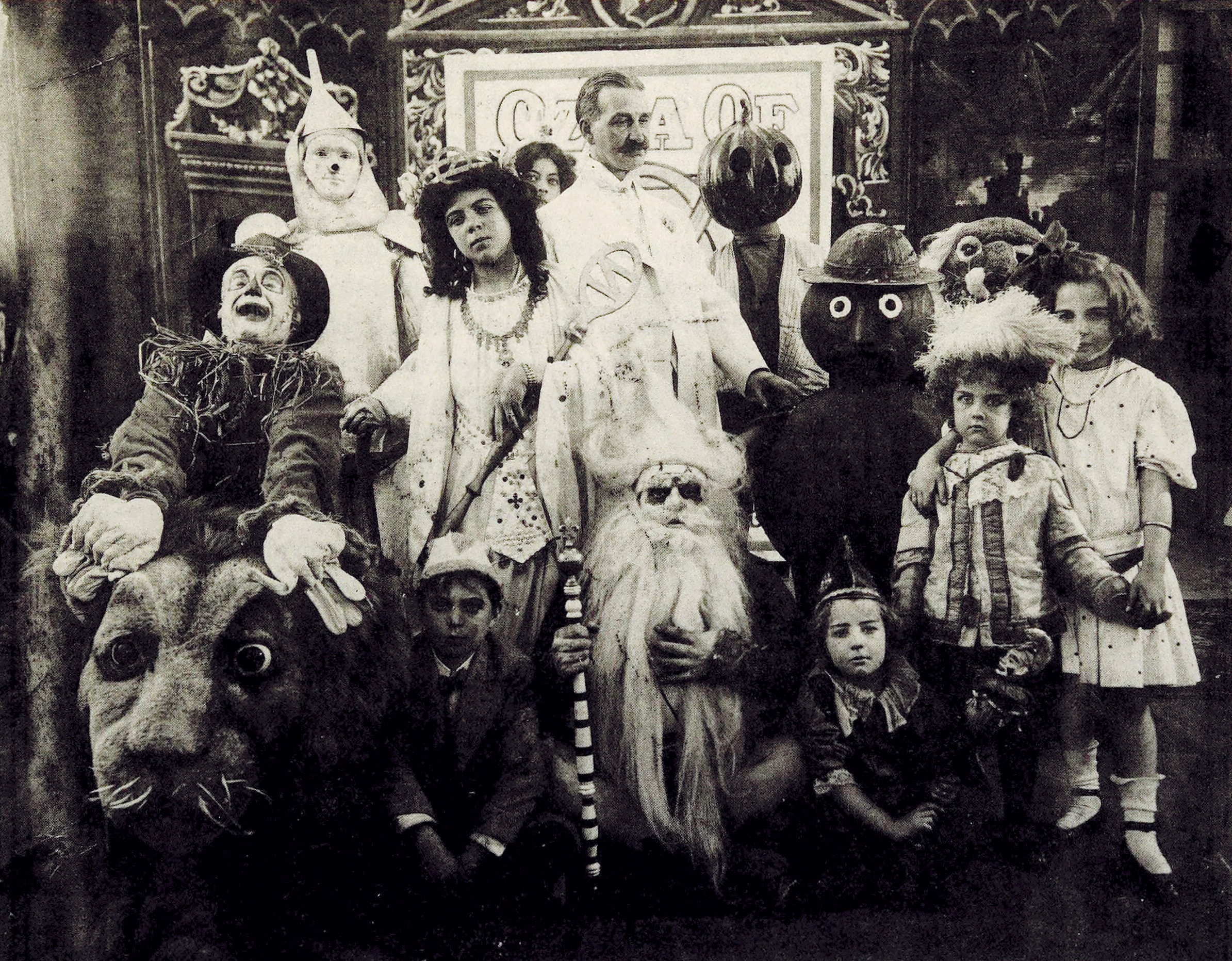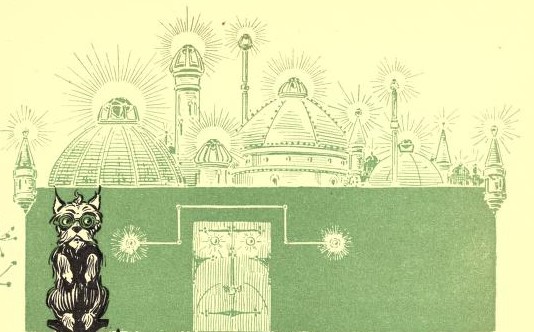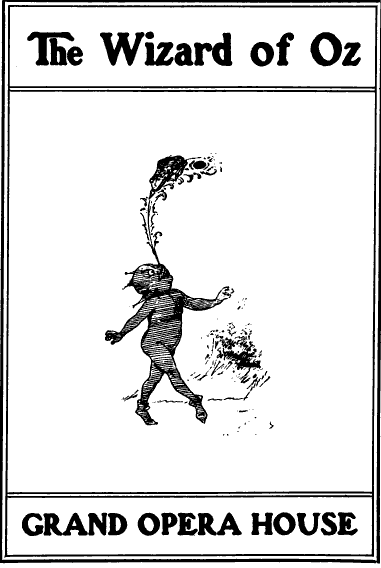|
The Fairylogue And Radio-Plays
''The Fairylogue and Radio-Plays'' was an early attempt to bring L. Frank Baum's Oz books to the motion picture screen. It was a mixture of live actors, hand-tinted magic lantern slides, and film. Baum himself would appear as if he were giving a lecture, while he interacted with the characters (both on stage and on screen). Although acclaimed throughout its tour, the show experienced budgetary problems (with the show costing more to produce than the money that sold-out houses could bring in) and folded after two months of performances. It opened in Grand Rapids, Michigan on September 24, 1908. It then opened in Orchestra Hall in Chicago on October 1, toured the country and ended its run in New York City. There, it was scheduled to run through December 31, and ads for it continued to run in ''The New York Times'' until then, but it reportedly closed on December 16. After First National Pictures acquired Selig Polyscope, the film was re-released on September 24, 1925. Although tod ... [...More Info...] [...Related Items...] OR: [Wikipedia] [Google] [Baidu] |
Francis Boggs
Francis Winter Boggs (March 1870 – October 27, 1911) was an American stage actor and pioneer silent film film director, director. He was one of the first to direct a film in Hollywood, Los Angeles, California, Hollywood. Biography He was born in Santa Rosa, California to George W. Boggs and Alabama McMeans. While in his teens he began acting with the Alcazar stock company in San Francisco and toured the Southwestern United States, American southwest. In 1900, he moved to Los Angeles, but in 1902, he went to Chicago, where he continued to work in theatre. There, he met William Nicholas Selig and in 1907 became involved with the making of motion pictures at Selig's Selig Polyscope Company, Polyscope studios in Chicago. With cameraman and jack of all trades Thomas Persons, Boggs made one of his earliest films, ''Monte Cristo''. He completed the interior shots at the Chicago studio, but shot the scenes of Edmond Dantès emerging from the sea at the beach near Los Angeles. In Chi ... [...More Info...] [...Related Items...] OR: [Wikipedia] [Google] [Baidu] |
Lost Film
A lost film is a feature or short film that no longer exists in any studio archive, private collection, public archive or the U.S. Library of Congress. Conditions During most of the 20th century, U.S. copyright law required at least one copy of every American film to be deposited at the Library of Congress at the time of copyright registration, but the Librarian of Congress was not required to retain those copies: "Under the provisions of the act of March 4, 1909, authority is granted for the return to the claimant of copyright of such copyright deposits as are not required by the Library." A report created by Library of Congress film historian and archivist David Pierce claims: * 75% of original silent-era films have perished. * 14% of the 10,919 silent films released by major studios exist in their original 35 mm or other formats. * 11% survive only in full-length foreign versions or film formats of lesser image quality. Of the American sound films made from 1927 to 1 ... [...More Info...] [...Related Items...] OR: [Wikipedia] [Google] [Baidu] |
John Dough And The Cherub
''John Dough and the Cherub'' is a children's fantasy novel, written by American author L. Frank Baum, about a living gingerbread man and his adventures. It was illustrated by John R. Neill and published in 1906 by the Reilly & Britton Company. The story was serialized in the Washington Sunday Star and other newspapers from October to December 1906. Like the Oz books but unlike many of the author's other works, ''John Dough'' was issued under Baum's name rather than one of his pseudonyms. The book was popular; as late as 1919 it was selling 1500 copies a year. The 1974 Dover Publications edition features an introduction by Martin Gardner. Gender ambiguity Throughout his text, Baum is careful never to specify the sex of the character Chick the Cherub, even to the point of referring to Chick as "it" instead of "he" or "she." Chick dresses in androgynous pajamas; Neill pictures Chick in a Buster Brown haircut that could fit either a boy or a girl. The publishers wanted Baum to re ... [...More Info...] [...Related Items...] OR: [Wikipedia] [Google] [Baidu] |
Ozma Of Oz
''Ozma of Oz: A Record of Her Adventures with Dorothy Gale of Kansas, Billina the Yellow Hen, the Scarecrow, the Tin Woodman, the Cowardly Lion and the Hungry Tiger; Besides Other Good People Too Numerous to Mention Faithfully Recorded Herein'', published on July 30, 1907, was the official third book of L. Frank Baum's List of Oz books, Oz series. It was the first in which Baum was clearly intending a series of Oz books.Peter Glassman, "Afterword," p 271 L. Frank Baum, ''Ozma of Oz'', It is the first Oz book where the majority of the action takes place outside of the Land of Oz. Only the final two chapters take place in Oz itself. This reflects a subtle change in theme: in the first book, Oz is the dangerous land through which Dorothy must win her way back to Kansas; in the third, Oz is the end and aim of the book. Dorothy's desire to return home is not as desperate as in the first book, and it is her uncle's need for her rather than hers for him that makes her return. The book w ... [...More Info...] [...Related Items...] OR: [Wikipedia] [Google] [Baidu] |
The Marvelous Land Of Oz
''The Marvelous Land of Oz: Being an Account of the Further Adventures of the Scarecrow and the Tin Woodman'', commonly shortened to ''The Land of Oz'', published in July 1904, is the second of L. Frank Baum's books set in the Land of Oz, and the sequel to ''The Wonderful Wizard of Oz'' (1900). This and the next 34 Oz books of the famous 40 were illustrated by John R. Neill. The book was made into an episode of ''The Shirley Temple Show'' in 1960, and into a Canada/Japan co-produced animated series of the same name in 1986. It was also adapted in comic book form by Marvel Comics; once in 1975 in the Marvel Treasury of Oz series, and again in an eight issue series with the first issue being released in November 2009. Plot elements from ''The Marvelous Land of Oz'' are included in the 1985 Disney feature film ''Return to Oz''. Plot summary The events are set shortly after the events in ''The Wonderful Wizard of Oz'' and after Dorothy Gale's departure back to Kansas. The protagoni ... [...More Info...] [...Related Items...] OR: [Wikipedia] [Google] [Baidu] |
The Wonderful Wizard Of Oz
''The Wonderful Wizard of Oz'' is a children's novel written by author L. Frank Baum and illustrated by W. W. Denslow. It is the first novel in the Oz series of books. A Kansas farm girl named Dorothy ends up in the magical Land of Oz after she and her pet dog Toto are swept away from their home by a tornado. Upon her arrival in Oz, she learns she cannot return home until she has destroyed the Wicked Witch of the West. The book was first published in the United States in May 1900 by the George M. Hill Company. In January 1901, the publishing company completed printing the first edition, a total of 10,000 copies, which quickly sold out. It had sold three million copies by the time it entered the public domain in 1956. It was often reprinted under the title ''The Wizard of Oz'', which is the title of the successful 1902 Broadway musical adaptation as well as the classic 1939 live-action film. The ground-breaking success of both the original 1900 novel and the 1902 Broadway ... [...More Info...] [...Related Items...] OR: [Wikipedia] [Google] [Baidu] |
The Assassination Of The Duke Of Guise
''The Assassination of the Duke of Guise'' (1908) (original French title: ''La Mort du duc de Guise''; often referred to as ''L'Assassinat du duc de Guise'') is a French historical film directed by Charles le Bargy and André Calmettes, adapted by Henri Lavedan, and featuring actors of the Comédie-Française and prominent set designers. It is one of the first films to feature both an original film score, composed by Camille Saint-Saëns,Davis, Richard (1999). ''Complete Guide to Film Scoring'', Berklee Press, Boston. , p. 17 and a screenplay by an eminent screenwriter.Magill's Survey of Silent Films, Vol.1 A-FLA p.155 edited by Frank N. Magill c.1982 (3 book set ) Synopsis Lasting longer than was then usual, about 15 minutes, the film more or less accurately depicts the events of the day in 1588 when King Henry III (played by co-director le Bargy) summoned his powerful rival, Duke Henri de Guise, to his chambers at the Château de Blois and had him brutally murdered. The film ... [...More Info...] [...Related Items...] OR: [Wikipedia] [Google] [Baidu] |
Camille Saint-Saëns
Charles-Camille Saint-Saëns (; 9 October 183516 December 1921) was a French composer, organist, conductor and pianist of the Romantic music, Romantic era. His best-known works include Introduction and Rondo Capriccioso (1863), the Piano Concerto No. 2 (Saint-Saëns), Second Piano Concerto (1868), the Cello Concerto No. 1 (Saint-Saëns), First Cello Concerto (1872), ''Danse macabre (Saint-Saëns), Danse macabre'' (1874), the opera ''Samson and Delilah (opera), Samson and Delilah'' (1877), the Violin Concerto No. 3 (Saint-Saëns), Third Violin Concerto (1880), the Symphony No. 3 (Saint-Saëns), Third ("Organ") Symphony (1886) and ''The Carnival of the Animals'' (1886). Saint-Saëns was a musical prodigy; he made his concert debut at the age of ten. After studying at the Paris Conservatoire he followed a conventional career as a church organist, first at Saint-Merri, Paris and, from 1858, La Madeleine, Paris, La Madeleine, the official church of the Second French Empire, Fren ... [...More Info...] [...Related Items...] OR: [Wikipedia] [Google] [Baidu] |
The Wizard Of Oz (1902 Stage Play)
''The Wizard of Oz'' was a 1902 musical extravaganza based on the 1900 novel ''The Wonderful Wizard of Oz'' by L. Frank Baum. Although Baum is the credited bookwriter, Glen MacDonough was hired on as jokewriter after Baum had finished the script. Much of the original music was by Paul Tietjens and has been mostly forgotten, although it was still well-remembered and in discussion at MGM in 1939 when the classic film version of the story was made. The show's history is covered in more than 100 pages of the book '' Oz Before the Rainbow; L Frank Baum's 'The Wonderful Wizard of Oz' on stage and screen to 1939'' by Mark Evan Swartz. The show premiered at the Chicago Grand Opera House on June 16, 1902 and then went on tour throughout the upper Midwest before moving to the Majestic Theatre on Broadway on January 21, 1903, where it ran for 293 performances through October 3. A second company was established, and the show went on tour from September 1903 through March 1904 before r ... [...More Info...] [...Related Items...] OR: [Wikipedia] [Google] [Baidu] |
Film Music
A film score is original music written specifically to accompany a film. The score comprises a number of orchestral, instrumental, or choral pieces called cues, which are timed to begin and end at specific points during the film in order to enhance the dramatic narrative and the emotional impact of the scene in question. Scores are written by one or more composers under the guidance of or in collaboration with the film's director or producer and are then most often performed by an ensemble of musicians – usually including an orchestra (most likely a symphony orchestra) or band, instrumental soloists, and choir or vocalists – known as playback singers – and recorded by a sound engineer. The term is less frequently applied to music written for other media such as live theatre, television and radio programs, and video game, and said music is typically referred to as either the soundtrack or incidental music. Film scores encompass an enormous variety of styles of ... [...More Info...] [...Related Items...] OR: [Wikipedia] [Google] [Baidu] |
Documentary Film
A documentary film or documentary is a non-fictional film, motion-picture intended to "document reality, primarily for the purposes of instruction, education or maintaining a Recorded history, historical record". Bill Nichols (film critic), Bill Nichols has characterized the documentary in terms of "a filmmaking practice, a cinematic tradition, and mode of audience reception [that remains] a practice without clear boundaries". Early documentary films, originally called "actuality films", lasted one minute or less. Over time, documentaries have evolved to become longer in length, and to include more categories. Some examples are Educational film, educational, observational and docufiction. Documentaries are very Informational listening, informative, and are often used within schools as a resource to teach various principles. Documentary filmmakers have a responsibility to be truthful to their vision of the world without intentionally misrepresenting a topic. Social media platfor ... [...More Info...] [...Related Items...] OR: [Wikipedia] [Google] [Baidu] |
Travel Literature
The genre of travel literature encompasses outdoor literature, guide books, nature writing, and travel memoirs. One early travel memoirist in Western literature was Pausanias, a Greek geographer of the 2nd century CE. In the early modern period, James Boswell's ''Journal of a Tour to the Hebrides'' (1786) helped shape travel memoir as a genre. History Early examples of travel literature include the ''Periplus of the Erythraean Sea'' (generally considered a 1st century CE work; authorship is debated), Pausanias' ''Description of Greece'' in the 2nd century CE, ''Safarnama'' (Book of Travels) by Nasir Khusraw (1003-1077), the '' Journey Through Wales'' (1191) and '' Description of Wales'' (1194) by Gerald of Wales, and the travel journals of Ibn Jubayr (1145–1214), Marco Polo (1254–1354), and Ibn Battuta (1304–1377), all of whom recorded their travels across the known world in detail. As early as the 2nd century CE, Lucian of Samosata discussed history and tr ... [...More Info...] [...Related Items...] OR: [Wikipedia] [Google] [Baidu] |



_p136.jpg)





